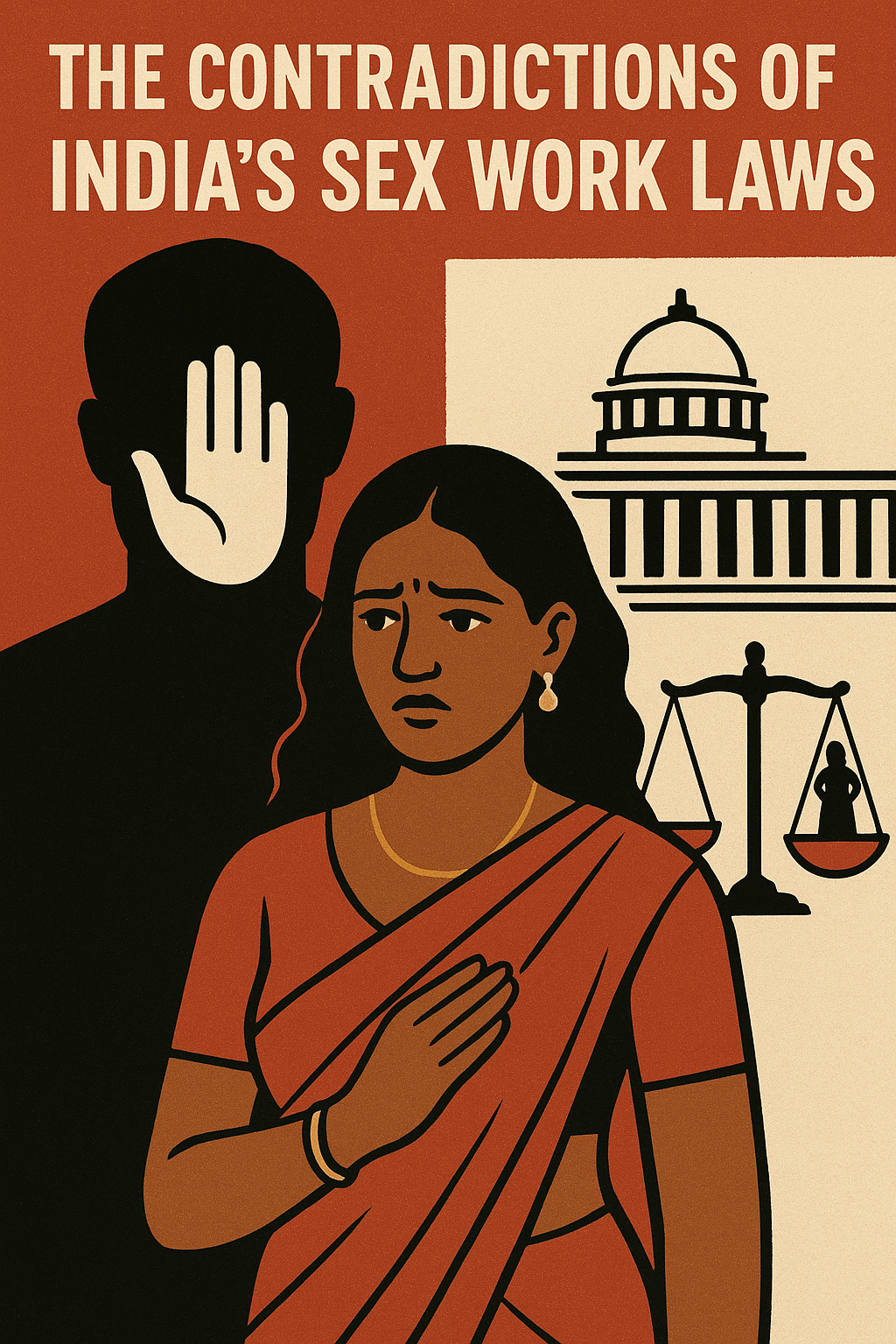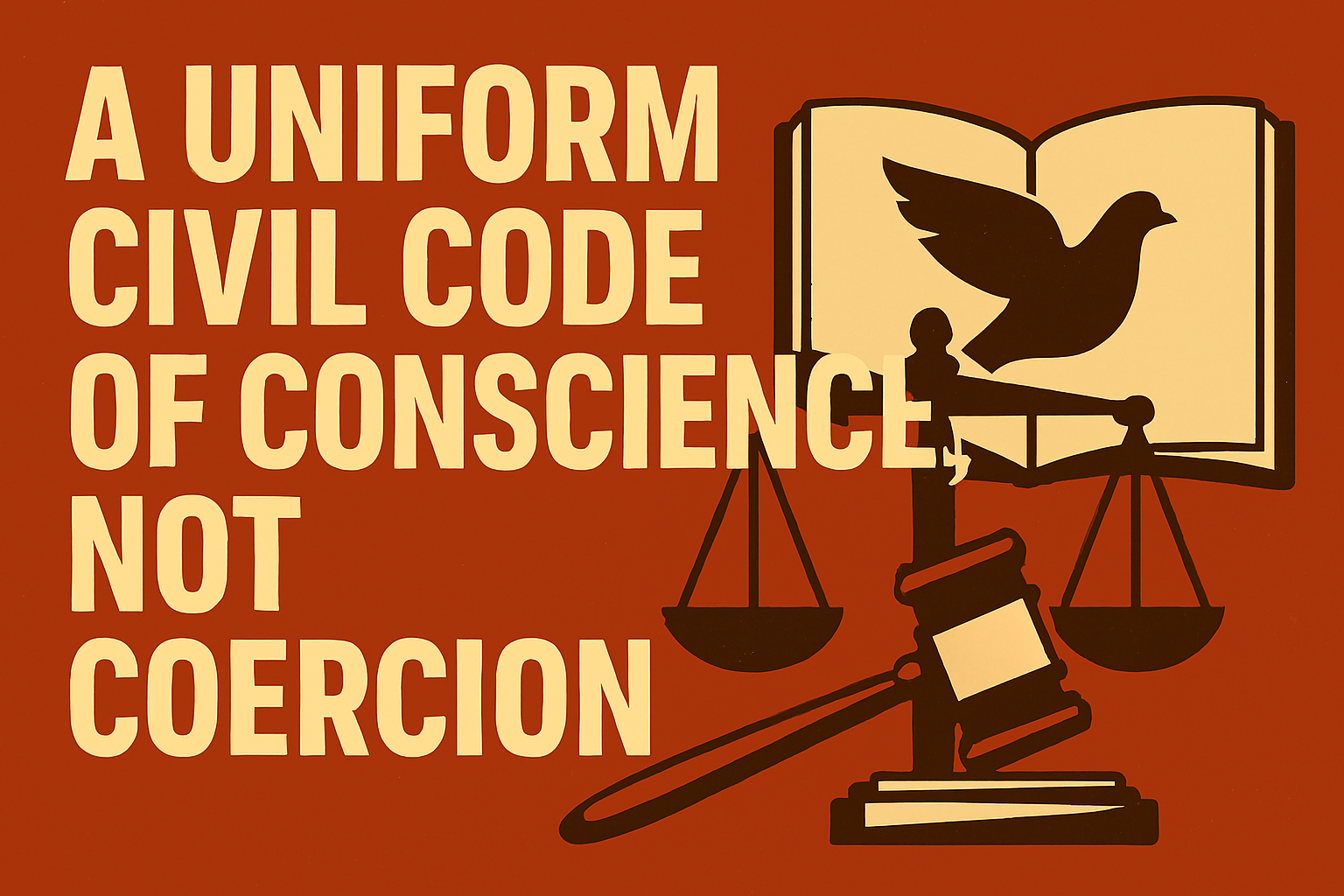



Author: Athira Narayanan
University: Symbiosis School For Liberal Arts
In a country where gods change every door, dialects change every few kilometres and a culture constitutes the very ethos of the nation’s functioning, can there be a singular way to define justice? Uniform Civil Code or UCC, has for long been at the crossroads of India’s democratic ideals. It promises a set of secular civil laws that govern all citizens equally. As India stands at the cusp of a social transformation, the UCC becomes not just a legal reform, but a mirror to our collective conscience and a test of India’s very secular fabric, its democratic resilience and its ability to balance progress with pluralism.
UCC proposes a singular set of laws governing marriage, divorce, inheritance and adoption for all Indian citizens irrespective of their religion, caste and gender. Enshrined in the Directive Principles of State Policy in Article 44 of the Indian Constitution, the UCC is viewed by many as a step towards true legal egalitarianism. At the heart of this debate lies a paradox. How can a country, especially as diverse as ours, uphold individual rights while also safeguarding community identities? His friction becomes especially profound since the Indian Constitution guarantees equality before law (Article 14) and the freedom to practice and propagate religion (Article 25).
Ultimately, the question goes beyond whether we need a Uniform Civil Code, but whether it can be one that embodies justice without erasure and imposition, and unity without uniformity.
Historical Roots
To entirely understand the complexity of the Uniform Civil Code, we need to return to the crucible in which this idea was formed. The debate around UCC is deeply embedded in India’s colonial past and post-colonial imagination. The roots of personal law divergence trace back to British colonial times, when they strategically chose to govern Hindus and Muslims under religious customs in matters concerning family law, while criminal and civil law were codified uniformly. This led to the creation of a dual legal system, a uniform set of laws for public conduct, and a religion-based personal law for private matters.
Dr. B.R. Ambedkar, the chief architect of the Indian Constitution was however a strong proponent of the uniform civil code. He believed that laws should not be rooted in religious doctrine, but in reason and justice instead. He was met with resistance from various members of the drafting committee fearing that a uniform code would infringe upon the freedom of minorities, particularly Muslims. This led to a compromise; the UCC was included not as a fundamental right, but instead under the Directive Principles of State Policy, which made this simply a moral directive to the state and not a legal obligation. Over the decades, the Indian judiciary has repeatedly nudged the legislature towards the UCC. A landmark moment in this direction was the Shah Bano Case (1985), where the Supreme Court upheld the right of Shah Bano, a Muslim woman, to maintenance under Section 125 of the Criminal Procedure Code, despite personal laws suggesting otherwise. The court then believed that a common civil code could help in national integration by minimising conflicting ideologies. Despite this judicial decision, there was mass political backlash which led to the passing of the Muslim Women (Protection of Rights on Divorce) Act, 1986 to nullify the Court’s judgment. The events that followed revealed the political instability and the communal volatility of India at the time.
Pluralism, Identity, and Cultural Autonomy
While many view Uniform Civil Code as a progressive legal reform, critics argue to be cautious about the layered and complex nature of India’s history. The opposition to UCC is not an outright dismissal of the code, but rather a concern about how it’s being conceptualized, propagated and potentially implemented.
At the core of its resistance is a fear of majoritarianism taking over, particularly the dominant Hindu cultural ethos being imposed on the religious minorities in India. Other communities in India view personal laws as more than just legal frameworks; they have become an expression of faith and cultural identity. They predict UCC to flatten diversity, and view it as a seemingly neutral but essentially majoritarian framework. The fear isn’t of law in itself, but rather who writes these laws, and whose values shape it, and whether all communities will be granted an equal voice in that process.
Reform vs. Imposition
There is a crucial difference between reforming discriminatory practices within existing personal laws and imposing a monolithic code in the name of equality. The latter can be dangerous to the very ethos of our country. Experts emphasize that the goal instead of a uniform code should be internal reform, facilitated through research, dialogue, education and community leadership. For instance, many women’s rights groups have advocated for a gender-just interpretation of Islamic law from within the tradition, rather than a complete legislative overhaul that could marginalise the very community it seeks to protect. Such an approach respects both constitutional values as well as cultural autonomy, as opposed to positioning them against each other. The absence of a concrete draft of the proposed UCC also fuels fear. It raises the question, How can communities support or critique a law they haven’t seen?
Tribal and Indigenous Communities
One of the most overlooked concerns in the UCC debate is that of tribal and indigenous people, who follow customary laws deeply embedded in oral traditions, communal rituals and environmental worldviews. More times than often, these laws do not align well with codified legal systems, but are in any way integral to social cohesion and governance of these communities. In many parts of the Northeast, for instance, tribal laws do a much better job at reflecting the community’s collective value of ownership, matriliny or customary adjudication and thus are responsible for personal matters like marriage, inheritance and dispute.
Another essential point that shouldn’t go unnoticed is that Article 371 and the Sixth Schedule of the Constitution specifically protect the sovereignty of tribal areas in terms of governance and law. Any code that fails to respect this would essentially violate constitutional safeguards and ruin the federal fabric of India. A blanket UCC could thus displace legal traditions, leading to legal alienation and cultural erosion.
Political Instrumentalization of UCC
The last and major criticism of UCC is its frequent political weaponisation of UCC, where rather than being a matter of civil rights and social justice, it is often framed electorally, making one question the real motive behind such moves. There has been periodic resurfacing of this matter often during election seasons or moments of communal tensions, which validates the rising suspicions about the sincerity and intent behind these reforms. In the past, the conversations surrounding a uniform code have been done with timing and rhetoric that reinforce the notion that specific communities are ‘targets’.
This politicisation of UCC simply erodes the trust of the masses, the most crucial aspect in a democracy, especially of minorities, who have begun to perceive UCC as a threat, as an assertion of cultural dominance, rather than a reformative measure. This distrust is further exacerbated when legal reform is pursued without transparent consultation or legislative clarity.
The Goa Exception
A frequently adduced example in contemporary discourse of Uniform Civil Code in action is that of The State of Goa, the only Indian state to enforce a form of uniform civil law applicable to all its citizens, irrespective of religion. While this system is often upheld as evidence that a uniform code can coexist within our diverse legal landscape, the ‘Goa Model’ is much more complex and limited than the popular assumption.
The founding blocks of Goa’s civil law lie in the Portuguese Civil Code of 1867, which continued to remain in force even after the state’s integration into the Indian Union in 1961. Unlike the rest of India, Goa continued with the implementation of the colonial civil code which governed personal matters like marriage, divorce, succession etc. in a secular manner. However, the Goa Civil Code is not entirely uniform. It grants certain religion-based exemptions in specific circumstances, and most provisions continue to reflect Catholic canon law, particularly about church marriages. While the Goan Civil Code is progressive in some parts, it suffers from certain gaps and ambiguities. For instance, Muslim personal law is not codified in Goa, but Muslim residents are not always subject to the Goa Civil Code. Additionally, the lack of timely legislative revision has resulted in outdated provisions remaining in force, some of which go against the broader constitutional framework of gender equality and individual autonomy.
While Goa’s experience shows us that a codified law can function within the Indian legal system, multiple distinctions make it work. For one, the scale and demographic specificity of Goa are not representative of the wider Indian context, which consists of a much wider ethno-religious demographic. Moreover, the Goan civil code is a continued existence of colonial residue and not a result of deliberative legislative engagement with Indian communities across communities. Thus, while the Goan Model offers a precedent for civil law codification, it cannot be hailed as a prototype for a Uniform Civil Code across the nation. In other words, it should be simply treated as a reference point, and not a template for UCC in India.
Conclusion
In the mosaic of modern India, UCC must transcend mere legal uniformity. It must be responsive to the plural history and gender equality while remaining respectful of lived identities.
However, accommodating the needs, aspirations and vision for a country of 1.3 billion people has never been an easy task. The challenge in this case,
It’s important to acknowledge the cultural differences that exist across the distinct cultures in India. A much more gradual approach, beginning with identifying and amending discriminatory sections within existing personal laws. From colonial genesis of these personal laws, to judicial intervention and hesitance of law commissions, it is clear that UCC must not be approached as a monolithic ambition, but a constitutionally grounded progress rooted in dialogue and inclusivity.
Like Ambedkar once envisioned, a Uniform Civil Code must not extinguish India’s diversity, but rather illuminate India’s shared commitment to dignity, equality and harmony. And thus the challenge thus lies not in the code, but our courage and willingness to codify justice.
Reference-